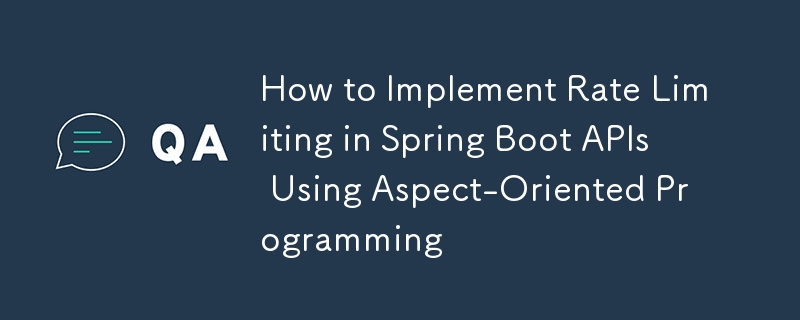如何使用面向方面的编程在 Spring Boot API 中实现速率限制

我在业余项目中学到的东西......
简介:面向方面编程(AOP)是 Spring Boot 中的一项强大技术,用于将横切关注点与主应用程序逻辑分离。 AOP 的一个常见用例是在 API 中实施速率限制,即限制客户端在特定时间内可以发出的请求数量。在本文中,我们将探讨如何利用 AOP 在 Spring Boot API 中实现速率限制,确保最佳性能和资源利用率。
目录:
- 了解面向方面的编程 (AOP)
- 在 Spring Boot 中使用 AOP 实现速率限制
- 示例:Spring Boot API 中的速率限制
- 结论
1.理解面向方面编程(AOP)
面向方面的编程是一种编程范式,旨在模块化软件开发中的横切关注点。横切关注点是影响多个模块的程序的各个方面,并且很难使用传统方法进行模块化。示例包括日志记录、安全性和事务管理。
AOP 引入了方面的概念,它封装了横切关注点。方面是模块化单元,可以跨应用程序的不同部分应用,而无需修改核心逻辑。 AOP 框架(例如 Spring AOP)提供了定义切面并将其应用于应用程序执行流中特定连接点的机制。
2. Spring Boot中使用AOP实现速率限制
速率限制是 Web API 中的一项常见要求,旨在防止滥用并确保资源的公平使用。通过 Spring Boot 中的 AOP,我们可以通过拦截方法调用并限制一定时间范围内允许的请求数量来实现速率限制。
要在 Spring Boot 中使用 AOP 实现速率限制,我们通常遵循以下步骤:
- 定义自定义注释来标记应限制速率的方法。
- 创建一个切面类,拦截使用自定义注释注释的方法调用。
- 使用速率限制器组件来跟踪和实施速率限制。
- 优雅地处理超出速率限制的情况,例如抛出自定义异常。
3. 示例:Spring Boot API 中的速率限制
在 Spring Boot API 中实现速率限制可以使用各种技术来实现。一种常见的方法是使用 Spring AOP(面向方面编程)来拦截传入请求并强制执行速率限制。
第 1 步 - 定义速率限制配置: 创建一个配置类,在其中定义速率限制参数,例如允许的请求数量和时间段。
@Configuration
public class RateLimitConfig {
@Value("${rate.limit.requests}")
private int requests;
@Value("${rate.limit.seconds}")
private int seconds;
// Getters and setters
}
第 2 步 — 创建速率限制方面: 使用 Spring AOP 实现一个方面来拦截方法调用并强制执行速率限制。
@Aspect
@Component
public class RateLimitAspect {
@Autowired
private RateLimitConfig rateLimitConfig;
@Autowired
private RateLimiter rateLimiter;
@Around("@annotation(RateLimited)")
public Object enforceRateLimit(ProceedingJoinPoint joinPoint) throws Throwable {
String key = getKey(joinPoint);
if (!rateLimiter.tryAcquire(key, rateLimitConfig.getRequests(), rateLimitConfig.getSeconds())) {
throw new RateLimitExceededException("Rate limit exceeded");
}
return joinPoint.proceed();
}
private String getKey(ProceedingJoinPoint joinPoint) {
// Generate a unique key for the method being called
// Example: method signature, user ID, IP address, etc.
// You can customize this based on your requirements
}
}
第 3 步 — 定义 RateLimited 注释: 创建自定义注释来标记应限制速率的方法。
@Target(ElementType.METHOD)
@Retention(RetentionPolicy.RUNTIME)
public @interface RateLimited {
}
第 4 步 - 实施速率限制器: 创建速率限制器组件,以使用令牌桶算法或任何其他合适的算法来管理速率限制。
@Component
public class RateLimiter {
private final Map<String,RateLimitedSemaphore> semaphores = new ConcurrentHashMap<>();
public boolean tryAcquire(String key, int requests, int seconds) {
// Get the current timestamp
long currentTime = System.currentTimeMillis();
// Calculate the start time of the time window (in milliseconds)
long startTime = currentTime - seconds * 1000;
// Remove expired entries from the semaphore map
cleanupExpiredEntries(startTime);
// Get or create the semaphore for the given key
RateLimitedSemaphore semaphore = semaphores.computeIfAbsent(key, k -> {
RateLimitedSemaphore newSemaphore = new RateLimitedSemaphore(requests);
newSemaphore.setLastAcquireTime(currentTime); // Set last acquire time
return newSemaphore;
});
// Check if the semaphore allows acquiring a permit
boolean acquired = semaphore.tryAcquire();
if (acquired) {
semaphore.setLastAcquireTime(currentTime); // Update last acquire time
}
return acquired;
}
private void cleanupExpiredEntries(long startTime) {
Iterator<Map.Entry<String, RateLimitedSemaphore>> iterator = semaphores.entrySet().iterator();
while (iterator.hasNext()) {
Map.Entry<String, RateLimitedSemaphore> entry = iterator.next();
String key = entry.getKey();
RateLimitedSemaphore semaphore = entry.getValue();
if (semaphore.getLastAcquireTime() < startTime) {
iterator.remove();
}
}
}
private class RateLimitedSemaphore extends Semaphore {
private volatile long lastAcquireTime;
public RateLimitedSemaphore(int permits) {
super(permits);
}
public long getLastAcquireTime() {
return lastAcquireTime;
}
public void setLastAcquireTime(long lastAcquireTime) {
this.lastAcquireTime = lastAcquireTime;
}
}
}
第 5 步 - 注释控制器方法: 用 @RateLimited 注释应限制速率的控制器方法。
@RestController
public class MyController {
@RateLimited
@GetMapping("/api/resource")
public ResponseEntity<String> getResource() {
// Implementation
}
}
第 6 步 - 配置速率限制属性: 在 application.properties 或 application.yml 中配置速率限制属性。
rate.limit.requests=10 rate.limit.seconds=60
还有…
要通过IP地址限制请求,您可以从传入请求中提取IP地址并将其用作限速的关键。以下是您可以修改 getKey 方法以根据 IP 地址生成唯一密钥的方法:
private String getKey(HttpServletRequest request) {
// Get the IP address of the client making the request
String ipAddress = request.getRemoteAddr();
return ipAddress; // Use IP address as the key
}
您还需要修改 RateLimitAspect 类中的 enforceRateLimit 方法,以将 HttpServletRequest 对象传递给 getKey 方法:
@Around("@annotation(RateLimited)")
public Object enforceRateLimit(ProceedingJoinPoint joinPoint) throws Throwable {
// Get the current request from the JoinPoint
ServletRequestAttributes requestAttributes = (ServletRequestAttributes) RequestContextHolder.getRequestAttributes();
HttpServletRequest request = requestAttributes.getRequest();
String key = getKey(request);
if (!rateLimiter.tryAcquire(key, rateLimitConfig.getRequests(), rateLimitConfig.getSeconds())) {
throw new RateLimitExceededException("Rate limit exceeded");
}
return joinPoint.proceed();
}
在此示例中,我们定义了一个自定义注释 @RateLimited 来标记应限制速率的方法。然后,我们创建一个切面 RateLimitAspect,用于拦截用 @RateLimited 注释的方法调用。在该方面,我们使用 RateLimiter 组件强制执行速率限制。
4. 结论
在本文中,我们探讨了如何使用面向方面编程(AOP)在 Spring Boot API 中实现速率限制。通过将速率限制等横切关注点与核心应用程序逻辑分离,我们可以确保应用程序具有更好的模块化性、可维护性和可扩展性。 AOP 提供了解决此类问题的强大机制,使开发人员能够专注于构建健壮且高效的 API。
通过遵循本文概述的步骤并利用 Spring Boot 中的 AOP 功能,开发人员可以轻松在其应用程序中实现速率限制和其他横切关注点,从而实现更具弹性和高性能的 API。
以上是如何使用面向方面的编程在 Spring Boot API 中实现速率限制的详细内容。更多信息请关注PHP中文网其他相关文章!

热AI工具

Undresser.AI Undress
人工智能驱动的应用程序,用于创建逼真的裸体照片

AI Clothes Remover
用于从照片中去除衣服的在线人工智能工具。

Undress AI Tool
免费脱衣服图片

Clothoff.io
AI脱衣机

Video Face Swap
使用我们完全免费的人工智能换脸工具轻松在任何视频中换脸!

热门文章

热工具

记事本++7.3.1
好用且免费的代码编辑器

SublimeText3汉化版
中文版,非常好用

禅工作室 13.0.1
功能强大的PHP集成开发环境

Dreamweaver CS6
视觉化网页开发工具

SublimeText3 Mac版
神级代码编辑软件(SublimeText3)
 公司安全软件导致应用无法运行?如何排查和解决?
Apr 19, 2025 pm 04:51 PM
公司安全软件导致应用无法运行?如何排查和解决?
Apr 19, 2025 pm 04:51 PM
公司安全软件导致部分应用无法正常运行的排查与解决方法许多公司为了保障内部网络安全,会部署安全软件。...
 如何将姓名转换为数字以实现排序并保持群组中的一致性?
Apr 19, 2025 pm 11:30 PM
如何将姓名转换为数字以实现排序并保持群组中的一致性?
Apr 19, 2025 pm 11:30 PM
将姓名转换为数字以实现排序的解决方案在许多应用场景中,用户可能需要在群组中进行排序,尤其是在一个用...
 如何使用MapStruct简化系统对接中的字段映射问题?
Apr 19, 2025 pm 06:21 PM
如何使用MapStruct简化系统对接中的字段映射问题?
Apr 19, 2025 pm 06:21 PM
系统对接中的字段映射处理在进行系统对接时,常常会遇到一个棘手的问题:如何将A系统的接口字段有效地映�...
 如何优雅地获取实体类变量名构建数据库查询条件?
Apr 19, 2025 pm 11:42 PM
如何优雅地获取实体类变量名构建数据库查询条件?
Apr 19, 2025 pm 11:42 PM
在使用MyBatis-Plus或其他ORM框架进行数据库操作时,经常需要根据实体类的属性名构造查询条件。如果每次都手动...
 IntelliJ IDEA是如何在不输出日志的情况下识别Spring Boot项目的端口号的?
Apr 19, 2025 pm 11:45 PM
IntelliJ IDEA是如何在不输出日志的情况下识别Spring Boot项目的端口号的?
Apr 19, 2025 pm 11:45 PM
在使用IntelliJIDEAUltimate版本启动Spring...
 Java对象如何安全地转换为数组?
Apr 19, 2025 pm 11:33 PM
Java对象如何安全地转换为数组?
Apr 19, 2025 pm 11:33 PM
Java对象与数组的转换:深入探讨强制类型转换的风险与正确方法很多Java初学者会遇到将一个对象转换成数组的�...
 电商平台SKU和SPU数据库设计:如何兼顾用户自定义属性和无属性商品?
Apr 19, 2025 pm 11:27 PM
电商平台SKU和SPU数据库设计:如何兼顾用户自定义属性和无属性商品?
Apr 19, 2025 pm 11:27 PM
电商平台SKU和SPU表设计详解本文将探讨电商平台中SKU和SPU的数据库设计问题,特别是如何处理用户自定义销售属...
 如何利用Redis缓存方案高效实现产品排行榜列表的需求?
Apr 19, 2025 pm 11:36 PM
如何利用Redis缓存方案高效实现产品排行榜列表的需求?
Apr 19, 2025 pm 11:36 PM
Redis缓存方案如何实现产品排行榜列表的需求?在开发过程中,我们常常需要处理排行榜的需求,例如展示一个�...






